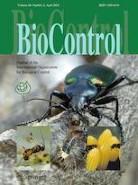Ver ítem
- xmlui.general.dspace_homeCentros e Institutos de InvestigaciónCICVyA. Centro de Investigación en Ciencias Veterinarias y AgronómicasInstituto de Microbiología y Zoología AgrícolaArtículos científicosxmlui.ArtifactBrowser.ItemViewer.trail
- Inicio
- Centros e Institutos de Investigación
- CICVyA. Centro de Investigación en Ciencias Veterinarias y Agronómicas
- Instituto de Microbiología y Zoología Agrícola
- Artículos científicos
- Ver ítem
Life history study of the mirid Tupiocoris cucurbitaceus feeding on Tuta absoluta eggs: implications for biological control and its combination with inherited sterility
Resumen
Tuta absoluta (Meyrick) (Lepidoptera: Gelechiidae) is a key pest of tomato crops. Tupiocoris cucurbitaceus (Spinola) (Hemiptera: Miridae) is a neotropical predator capable of consuming T. absoluta eggs. We evaluated the life history traits of T. cucurbitaceus on three different diets: T. absoluta eggs from irradiated parental males and untreated parents, and Sitotroga cerealella (Olivier) (Lepidoptera: Gelechiidae) eggs (control). The nymphal development
[ver mas...]
Tuta absoluta (Meyrick) (Lepidoptera: Gelechiidae) is a key pest of tomato crops. Tupiocoris cucurbitaceus (Spinola) (Hemiptera: Miridae) is a neotropical predator capable of consuming T. absoluta eggs. We evaluated the life history traits of T. cucurbitaceus on three different diets: T. absoluta eggs from irradiated parental males and untreated parents, and Sitotroga cerealella (Olivier) (Lepidoptera: Gelechiidae) eggs (control). The nymphal development of T. cucurbitaceus was reached in 13 days with a similar survival for all diets (58–65%). Mirid female longevity and oviposition period were statistically similar when the diets consisted of T. absoluta eggs from untreated parents and S. cerealella eggs, although the number of nymphs laid was larger with the second diet. Moreover, mirid females feeding on T. absoluta eggs from untreated parents lived longer and laid double number of nymphs than when fed on T. absoluta eggs from irradiated parental males. The highest intrinsic rate of increase (rm) was observed for the S. cerealella eggs diet, while differences were not observed between the two types of T. absoluta eggs. These results indicate that the mirid could develop and reproduce by feeding exclusively on both types of T. absoluta eggs. As conclusion, the use of more environmentally friendly strategies to control this pest, such as the biological control and inherited sterility, is possible through the release of T. cucurbitaceus and irradiated T. absoluta individuals.
[Cerrar]

Autor
Cagnotti, Cynthia Lorena;
Arias, Ariel E.;
Ermantraut, Erika N.;
Andorno, Andrea Veronica;
Viscarret, Mariana Mabel;
Lopez, Silvia Noemi;
Fuente
BioControl 66 (2) : 207-216 (April 2021)
Fecha
2021
Editorial
Springer
ISSN
1386-6141
1573-8248
1573-8248
Documentos Relacionados
Formato
pdf
Tipo de documento
artículo
Proyectos
(ver más)
INTA/2019-PE-E4-I074-001/2019-PE-E4-I074-001/AR./Manejo Integrado de Plagas
Palabras Claves
Derechos de acceso
Restringido
 Excepto donde se diga explicitamente, este item se publica bajo la siguiente descripción: Creative Commons Attribution-NonCommercial-ShareAlike 2.5 Unported (CC BY-NC-SA 2.5)
Excepto donde se diga explicitamente, este item se publica bajo la siguiente descripción: Creative Commons Attribution-NonCommercial-ShareAlike 2.5 Unported (CC BY-NC-SA 2.5)
Metadatos
Mostrar el registro completo del ítemÍtems relacionados
Mostrando ítems relacionados por Título, autor o materia.
-
Manejo de malezas en el cultivo de pecán
Taiariol, Dario (EEA Bella Vista, INTA, 2022-12-15)Una planta no deseada en un lugar no deseado. No siempre invasivas o salvajes. Efectos adversos de malezas. -En plantas jóvenes: Compite y afecta la disponibilidad de nutrientes, luz y agua y, además, alelopatías. - En ... -
Taladrillo de los forestales: algunos aspectos de su biología, detección y manejo de poblaciones
Cichon, Liliana; Garrido, Silvina Alejandra; Lago, Jonatan; Ahmad, Samir (EEA Alto Valle, INTA, 2013)Megaplatypus sulcatus Chapius, conocido vulgarmente como "barreno" o "taladrillo de los forestales", es un coleóptero que produce severos daños en plantaciones forestales y frutales perforando el tronco de los árboles, ... -
Revalorización del Complejo de Depredadores Polífagos Asociado al Cultivo de los Cítricos, Como Agentes de Control Biológico de Plagas Claves
Bouvet, Juan Pedro (Departamento de Producción Vegetal, Universitat Politècnica de València, 2018-12)Dentro de los enemigos naturales de plagas en los agroecosistemas, los depredadores han sido considerados como uno de los grupos de mayor importancia. Sin embargo, su compleja biología y comportamiento ha obstaculizado en ...

